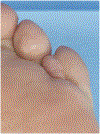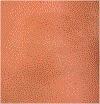Dermatologic findings in individuals with genetically confirmed Proteus syndrome
- PMID: 34105192
- PMCID: PMC8403137
- DOI: 10.1111/pde.14624
Dermatologic findings in individuals with genetically confirmed Proteus syndrome
Abstract
Background/objective: Proteus syndrome, caused by a mosaic activating AKT1 variant, typically presents in toddlers with progressive, asymmetric overgrowth of the skin and bones. We aimed to define the spectrum of dermatologic disease in individuals with genetically confirmed Proteus syndrome.
Methods: We conducted a retrospective review of records from dermatologic examinations of individuals evaluated at the NIH with a molecular diagnosis of Proteus syndrome. The types, prevalence, and localization of dermatologic findings were assessed.
Results: Fifty-one individuals (29 males, 22 females, mean age: 9 years) with clinical features of Proteus syndrome had the mosaic c.49G>A, p.Glu17Lys AKT1 variant. Fifty (98%) had at least one cutaneous feature constituting current clinical diagnostic criteria, including vascular malformations in 42 (82%), epidermal nevus in 41 (80%), volar cerebriform connective tissue nevi in 34 (67%), and adipose dysregulation in 30 (59%). Forty-nine (96%) had at least one dermatologic finding not included within the diagnostic criteria, including confluent volar skin-colored to hypopigmented papules or nodules (n = 33, 65%), papules or nodules on the digits or face (n = 27, 53%), and nonlinear epidermal nevi (n = 15, 29%). Other frequently observed features include nail changes (n = 28, 55%), hyperpigmented macules (n = 27, 53%), patchy dermal hypoplasia (n = 18, 35%), gingival/oral mucosal overgrowth (n = 17, 33%), hypopigmented macules (n = 16, 31%), dental enamel changes (n = 9, 18%), acrochordons (n = 6, 12%), and lingual overgrowth (n = 4, 8%).
Conclusions: The range of mucocutaneous features occurring in Proteus syndrome is broader than previously considered. These observations may assist in earlier diagnosis and management and provide novel insights regarding the pathogenesis of the condition.
Keywords: Genetic disease/mechanisms; genodermatoses; neoplasms-benign; skin signs of systemic disease; vascular malformations.
© Published 2021. This article is a U.S. Government work and is in the public domain in the USA.
Figures









References
-
- Biesecker LG, Sapp JC. Proteus Syndrome. 2012August9 [Updated 2019 Jan 10]. In: Adam MP, Ardinger HH, Pagon RA, et al., editors. GeneReviews® [Internet]. Seattle (WA): University of Washington, Seattle; 1993–2021. Available from: https://www.ncbi.nlm.nih.gov/books/NBK99495/. - PubMed
-
- Nguyen D, Turner JT, Olsen C, Biesecker LG, Darling TN. Cutaneous manifestations of proteus syndrome: correlations with general clinical severity. Arch Dermatol. 2004;140(8):947–953. - PubMed
MeSH terms
Grants and funding
LinkOut - more resources
Full Text Sources
Medical
Miscellaneous

